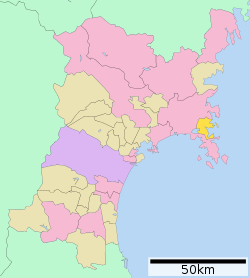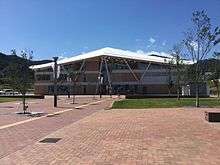Onagawa, Miyagi
| Onagawa 女川町 | |||
|---|---|---|---|
| Town | |||
|
Onagawa urban area in 1975 | |||
| |||
 Location of Onagawa in Miyagi Prefecture | |||
 Onagawa
| |||
| Coordinates: 38°26′17″N 141°27′00″E / 38.43806°N 141.45000°ECoordinates: 38°26′17″N 141°27′00″E / 38.43806°N 141.45000°E | |||
| Country | Japan | ||
| Region | Tōhoku | ||
| Prefecture | Miyagi | ||
| District | Oshika | ||
| Government | |||
| • -Mayor | Yoshiaki Suda | ||
| Area | |||
| • Total | 65.80 km2 (25.41 sq mi) | ||
| Population (June 2014) | |||
| • Total | 6,993 | ||
| • Density | 106/km2 (270/sq mi) | ||
| Time zone | Japan Standard Time (UTC+9) | ||
| - Tree | Cryptomeria | ||
| - Flower | Sakura | ||
| - Bird | Black-tailed gull | ||
| - Fish | Skipjack tuna | ||
| Phone number | 0225-54-3131 | ||
| Address | 136-banchi Onagawa Onagawahama, Onagawa-chō, Oshika -gun, Miyagi-ken 986-2292 | ||
| Website | Official website | ||
Onagawa (女川町 Onagawa-chō) is a coastal town located in Miyagi Prefecture, Japan. As of June 2014, the town had an estimated population of 6,993 and a population density of 106 persons per km². The total area was 65.80 km².
Geography
Onagawa is located on the rugged Sanriku Coast of north-central Miyagi Prefecture. Onagawa is a natural deep water port, located at the intersection of two major ocean currents and noted for its commercial fishing industry. Located nearby on the southern side of Onagawa Bay is the Onagawa Nuclear Power Plant.
Neighboring municipalities
- Miyagi Prefecture
History
The area of present-day Onagawa was part of ancient Mutsu Province, and has been settled since at least the Jomon period by the Emishi people. During later portion of the Heian period, the area was ruled by the Northern Fujiwara. During the Sengoku period, the area was contested by various samurai clans before the area came under the control of the Date clan of Sendai Domain during the Edo period, under the Tokugawa shogunate.
The modern village of Onagawa was established on 1 June 1889 with the establishment of the municipalities system.
The port of Onagawa, with its deep and sheltered harbor, has long been important both commercially and militarily. The port was hit by an air raid on 9 August 1945 which sank several ships, during the closing days of World War II. A memorial to Canadian Royal Navy Fleet Air Arm pilot Robert Hampton Gray who died in the attack, was unveiled in the town in 1989.
Onagawa was raised to town status on 1 April 1956.
2011 earthquake and tsunami
Onagawa was one of the most heavily damaged communities by the 11 March 2011 Tōhoku earthquake and tsunami. The tsunami reached in excess of 15 metres (49 ft) in height and swept 1 kilometre (0.62 mi) inland, claiming 827 lives and destroying 70% of the buildings in the town.[1][2] At least 12 of the town's 25 designated evacuation sites were inundated by the tsunami. The town's hospital located on a hill was extensively flooded on the first floor at the maximum recorded wave height of 18 meters. Six reinforced concrete buildings in the town of up to 4 stories in height were overturned by the force of the surging water and debris and Onagawa Station and its nearby railway tracks were also destroyed.[3]

In an incident widely reported in the Chinese media, Mitsuru Sato, managing director of Sato Suisan, a fish processing company in the town, gave his life ensuring that all the firm's workers, including 20 female Chinese resident trainees, had evacuated safely to higher ground.[4]
Whereas the Fukushima Daiichi Nuclear Power Plant suffered insufficient cooling in the wake of the tsunami which led to three nuclear meltdowns and the release of radioactive material, the Onagawa nuclear generation facility, much closer to the earthquake epicenter, survived the earthquake without any significant damage and served as an emergency refuge for the local community.[5]
The town had previously been hit by tsunami including that caused by the 1960 Valdivia earthquake, although it had received comparatively less impact from tsunami in the aftermath of the 1896 and 1933 Sanriku earthquakes.[6]
Seismologists note that the deep inlets and bays of the nearby ria coastline have the potential to amplify the destructiveness of tsunami waves.[7] Tsunami mitigation structures, warning systems and evacuation training have long been a feature of the town.
Post tsunami reconstruction

The local community's reconstruction efforts, in many cases led by Onagawa private sector business leaders, have outpaced many larger towns impacted by the 2011 Tōhoku earthquake and tsunami. Within days of the disaster privately owned construction machinery were used to clear roads, a wholesale fish market was relaunched on 1 April and a reconstruction advisory board was formed shortly thereafter. In the aftermath of the tsunami local residents successfully established small scale grocery stores and retail food facilities in a series of temporary market structures.
On March 21st, 2015 the reconstructed Onagawa Station reopened marking the restoration of the entire Ishinomaki Line. The new station building features an integrated community center and public bathing facility on the upper floors.[8]
Serving both the needs of the local community and attracting out of town visitors, a pedestrianized shopping promenade called Seapal Pia was opened in December 2015.
Five years after the tsunami many Onagawa residents continue to live in short-term temporary accommodation. After extensive landscaping, new residential housing is being relocated at higher elevations on nearby hillsides and leftover soil is being used to raise industrial and commercial sections closer to the water an average of 4.5 metres (15 ft) above sea level.[9]
Reconstruction has been supported both by central government funding and a number of private individuals and foundations including:
- The Qatar Friendship Fund, which provided US$24 million for the design and construction of a new fish processing and refrigerated storage facility.[10]
- Pritzker Architecture Prize winner Shigeru Ban, and the Voluntary Architects' Network, provided designs both for temporary housing shelters in the town as well as the rebuilt Onagawa Station building.[11]
Economy
The economy of Onagawa is largely based on commercial fishing. The town acts as a processing and distribution hub for variety of sea foods, but is particularly known for coho salmon, pacific saury and the cultivation of oysters.
Transportation
Railway
- East Japan Railway Company (JR East) – Ishinomaki Line
Highway
National highways
Ferry services
Local attractions
The town takes pride in the fact that it still has beaches with "squeaking sand", which has apparently become rare in Japan due to human induced environmental changes.[12]
Notable people from Onagawa
- Masatoshi Nakamura, actor[13]
References
- ↑ Kingston, Jeff (13 March 2016). "Onagawa is on the rebound from devastation". Japan Times. Retrieved 13 August 2016.
- ↑ India rescue team pitches in, The Japan Times 4 April 2011
- ↑ ビル屋上に車、駅は土台だけ…女川襲った津波 (in Japanese). Yomiuri Online. March 13, 2011. Retrieved September 10, 2011.
- ↑ Pulvers, Roger, "Japan's crises spark wide alarm and some unlikely sympathizers", The Japan Times, 27 March 2011, p. 8.
- ↑ Maeda, Risa (19 October 2011). "Japanese nuclear plant survived tsunami, offers clues". Reuters. Retrieved 14 August 2016.
- ↑ Kyodo News, "Tsunami hit more than 100 designated evacuation sites", The Japan Times, 14 April 2011, p. 1.
- ↑ Satake, Kenji (2005). Tsunamis: Case Studies and Recent Developments. Advances in Natural and Technological Hazards Research (Book 23). Springer. p. 99. ISBN 1402033265.
- ↑ "Onagawa Station Opening Ceremony". www.shigerubanarchitects.com. Shigeru Ban Architects. Retrieved 3 June 2015.
- ↑ Phelan, Steven (18 March 2016). "The Fall and Rise of Onagawa". New Yorker. Retrieved 14 August 2016.
- ↑ "Onagawa fishing sector back to glory, thanks to Qatar". The Peninsula. 11 March 2014. Retrieved 13 August 2016.
- ↑ "Onagawa Station Opening Ceremony". www.shigerubanarchitects.com. Shigeru Ban Architects. Retrieved 3 June 2015.
- ↑ Onagawa Town website
- ↑ Official profile Retrieved 7 September 2013. (Japanese)
External links
- Onagawa official website (Japanese)
- Phelan, Stephen (March–April 2013). "Washed Away". Boston Review.


